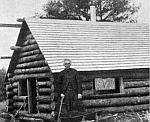Mason Walton, "Hermit of Gloucester"
The life of Mason Walton (1838-1917) is known, and he enjoyed many visitors to his hermitage during his life, but little of his eremitic motives are known. But two facts are outstanding: 1) his wife and child died early in their marriage, and Walton moved away from their original home, and 2) Walton enjoyed the outdoors and become an amateur naturalist, consumed by a love of animals and wilderness.
Mason Walton was born in Maine and had five siblings -- he was know as the quiet intelligent one. He spent much time in outdoor activities, and studied botany and ornithology in preparatory school. He edited a Greenback newspaper after the Civil War, and soon married. So far his was an uneventful life -- until his wife died in childbirth, and their child died a few hours later.
After several years, Walton took up accounting for a pharmaceutical company in Bangor, and was soon transferred to Boston. In Boston, he developed a severe respiratory infection. As one source says:
His health began to suffer, and he feared he had tuberculosis. "I resembled the living skeleton of a dime show," he would later write. Doctors advised him "to go into the woods and try life in a pine grove," but first Walton sought "a salt water cure." In the summer of 1884, he boarded a steamboat bound for Gloucester, hoping to find work on a fishing schooner. No skipper would have him -- so he followed his doctor's advice after all. He "turned to the hills" and pitched his tent "surrounded by pine groves." [Nelson]
Mason ended up pitching a tent on Bond Hill. When a severe winter storm
destroyed his tent, he asked the landowner if he could build a cabin, and did
so. Mason began his cure and found new inspiration for living.

He decided to dedicate his life to the study of flora, fauna and ornithology. Mason kept a daily journal of his findings and studies of "vernal ponds, vegetative growth, footprints and feathers." Eventually he made friends with some of the animals and gave them names: Triplefoot, a three-footed fox; Wabbles, a male sparrow; and Bismarck, a red squirrel. [Ramos]
Among [other animals he befriended] was Satan, the "artful raccoon," who
escaped a few months later. The Hermit also took in wounded creatures,
such as his song-sparrow, Wabbles, whose behavior he recorded in detail. He watched as Wabbles "set up a singing school and trained his boys to sing the mating-song of his species."He observed that the white-footed mice, who shared his cabin in the winter months (and occasionally shredded his papers), were mute and communicated "by drumming with their toes."
The Hermit derided Mr. Chewink, husband of a towhee he befriended, as a "lazy, good-for-nothing, shiftless fellow,” observing that he carried "not even a feather…to the new home."
On the other hand, Bismarck, his favorite red squirrel, he regarded as "quick-witted and resourceful." He watched with delight as Bismarck filled a "winter storehouse" at the base of a pine with first hazelnuts then beechnuts and acorns. [Nelson]
The anecdotes were recorded by Walton in his 1903 book, The Hermit’s Wild
Friends or
Eighteen Years in the Woods, which he dedicated it "to the lovers of nature,
everywhere."
But long before that, since 1880, Walton had been contributing regularly to the magazine that would become Field and Stream, writing a column under the pseudonym "The Hermit." His articles attracted visitors to his hermitage, as did his later book, so that at one point over 4,000 visitors a year were recorded, including "famous artists, writers, teachers, foreign ministers and wealthy tourists."
Walton died peacefully in his sleep in 1917 at the age of 79. His family buried him in Alton, Maine, next to the burial site of his wife and child. His cabin in the Gloucester forest (renamed Ravenwood) was destroyed by fire in 1948, and only a plaque placed there earlier remains on the site, reading:
In the cabin near this spot
Mason Walton
"Hermit of Gloucester"
Lover of Nature, Lived for thirty-three years
This tablet placed by the Gloucester Women's Club
1933
¶
BIBLIOGRAPHICAL REFERENCES
Liz Nelson: "The Hermit of Ravenwood" in Special Places, Fall 2006
v. 14, no. 3. p. 8-9. Trustees of the Reservation (http://www.thetrustees.org); Lisa Peek
Ramos: Magnolia, a Brief History. Charleston, SC: History Press, 2008 (pages
29-31 are on Walton; the town of Magnolia was close to Gloucester). Also
available is a ranger-led Ravenswood Park walking tour, "Hermit's Tale on
the Trails,"
described thusly: "Walk in the footsteps of the legendary Mason Walton to the
site of the cabin where he lived from 1884 to 1917. Along the way we'll closely
observe wildlife signs and determine behavior while sharing tales from Walton's
book, A Hermit’s Wild Friends."
http://www.thetrustees.org/pages/39228_hermit_s_tales_on_the_trails.cfm.
PDF: http://www.poeticsofplace.org/docs/Hermit%20of%20Ravenswood%20Quest.pdf